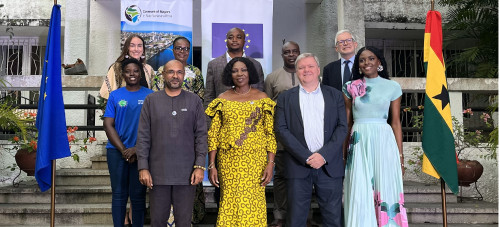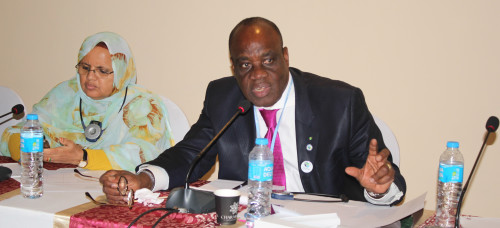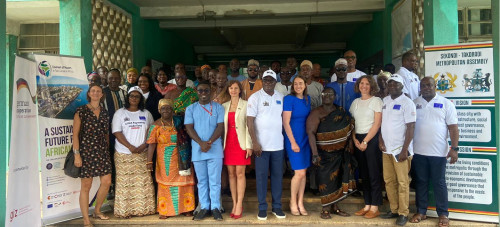Scaling up innovative climate action in Kenyan counties
Published: 17 Oct 2019

“If you want to go quickly, go alone. If you want to go far, go together.”
Kenya, already known for its climate leadership in East Africa, is making strides to fight climate change at the subnational level by empowering its counties to act on climate initiatives. As part of the Covenant of Mayors in Sub-Saharan Africa (CoM SSA) initiative (financed by the European Commission, BMZ and AECID), GIZ and ICLEI Africa explored some of these initiatives with the counties and engaged with national stakeholders to enable scaling of innovative climate solutions.
Devolution in Kenya has enabled the transfer of power, functions and allocation of resources to County Governments. Under this devolved government system, counties prepare County Integrated Development Plans and Climate Action Plans that enable planning for climate action and energy access at the county level. Counties are already undertaking climate action and exploring opportunities to scale up and find innovative climate solutions in Kenya.
GIZ and ICLEI Africa engaged with Nakuru, Mombasa and Makueni counties as part of the CoM SSA initiative, which supports local authorities to fight against climate change, and ensure sustainable energy access. The team explored, discussed and visited projects in the Counties that have good climate action practices and potential to scale-up.
Nakuru County, through its briquette project of turning human waste into money; lives up to their slogan – County of unlimited opportunities
Charcoal and wood fuels are the predominant sources of energy in Kenya, which has significantly contributed to deforestation in the country. At the same time, biomass provides for over 68% of the energy needs in households.
In responding to the challenge of deforestation alongside providing sustainable energy access to its population, a project in Nakuru county provides an alternative, environment-friendly biomass fuel – by turning human waste to briquettes. This is done through an innovative process that re-uses faecal matter and wastewater in biomass-fuel production to make carbonised briquettes. The product, popularly known as Makaa Dot Com, is cleaner, more efficient, cheaper than charcoal, lasts longer and has no smells as it burns!
Ran by NAWASSCOAL, a company owned by the county’s water utility, the briquette factory aims to increase its sales from the current 5 tonnes to between 150 and 250 tonnes in the next five years, enabling larger climate impact.
Mombasa County highlighted the importance of working together with different stakeholders to advance climate action. CoM SSA hosted a half-day workshop bringing together county officials across the departments of environment and waste; water and sanitation; disaster risk management; and even a community-based organisation that works closely with the county.
An interesting model the participants learnt about was the community driven, county-enabled and private sector supported collaboration on mangrove restoration.
The only Gazetted mangrove forest in Mombasa, which is now 45% degraded, is found along a local creek. The ‘Adopt-a-Site’ model by Big Ship, a CBO, engages stakeholders such as the county and private sector in active restoration of the mangrove forest, helping climate adaptation by creating a carbon sink.
As part of their corporate social initiative, the private sector “adopts” mangrove sites and provides financial support towards the project. Through the initiative, mangrove logging has decreased and communities have been given alternative sources of livelihood development through the sale of mangrove seedlings and bee farming.
Although this initiative is in line with the Governor’s 10% mangrove recovery strategy, it was initiated and evolved organically through the involvement of various stakeholders, demonstrating that action can happen without requiring lengthy formal processes. To scale up the success of this adopt-a-site-model, three mangrove sites will be added.
The Makueni County Climate Change Fund (CCCF)
Makueni’s county climate fund demonstrates innovative use of domestic public finance, to help increase access to resources available for implementation of adaptation priorities. This is achieved by ring-fencing climate funds in the county budget and involving people that are most vulnerable to the hazards of climate change in deciding how to spend them.
The CCCF is citizen-centred; it uses climate change planning committees to enable inclusive processes such as participatory vulnerability assessments and climate data to prioritise projects. The County facilitates the provision of technical support in the selection of impactful adaptation investments or services beneficial to the population. Aligning with national priorities set out in Kenya’s national adaptation plan, the County contributes in reinforcing national climate change policies, while delivering on local adaptation priorities.
The Kenyan counties and projects profiled really demonstrate that responding to the impacts of climate change requires the involvement of a range of stakeholders, and rings true to the African proverb: “If you want to go quickly, go alone. If you want to go far, go together.” In line with this, during the mission CoMSSA engaged with multiple stakeholders in Kenya, including the Council of Governors, various national government ministries, international organisations, financiers, development partners and the private sector to find ways of implementing and scaling-up climate solutions at the local level.





